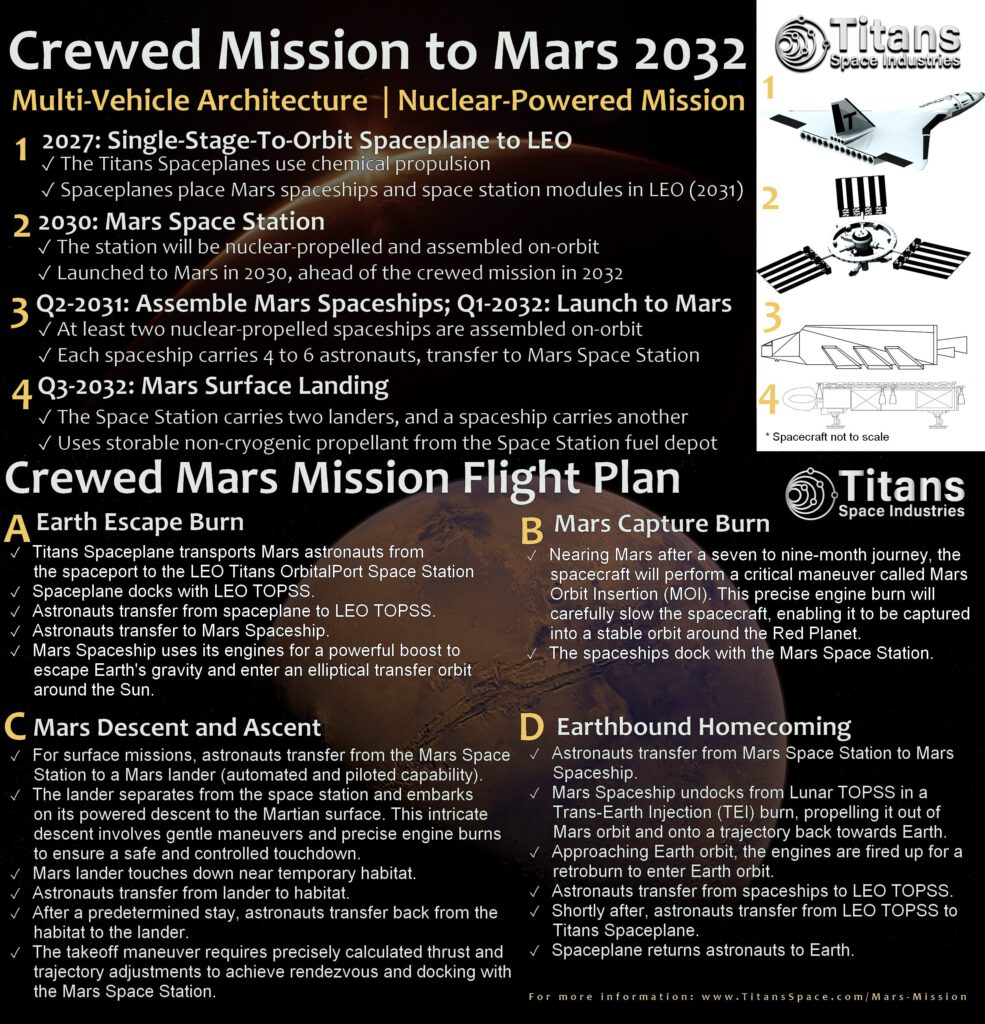Titans Space's Crewed Mars Mission: 2032
2030: Mars Exploration | 2032: Mars Colonization | 2034: Mars Industrialization
Multi-Vehicle Architecture Nuclear-Powered Crewed Mars Mission
Titans Space's Crewed Mars Mission: 2032 would have remained a stealth project until 2025, but now that NASA is revamping its Mars Sample Return program, aiming to get Martian rock and soil samples back to Earth sooner and cheaper, we deem the right time to make our intentions public.
These recent developments have motivated us to formally propose our capabilities and contribute to this critical space exploration endeavor. We will respond to NASA's upcoming RFI and also share it with the public in due time. For now, this summarized white paper serves to inform the public and all (potential) stakeholders of our planned architecture.

Crewed Mission to Mars | Flight Plan - From Earth to Mars and Back
Nuclear-Powered Missions | Frequent Flights from 2035 Onwards
Titans Space’s LEO, Lunar, and Mars infrastructure enable virtually unlimited transportation of humans and cargo from Earth to the Moon, and vice versa, and frequent transport to Mars.
This will revolutionize space travel, space exploration, and space commerce.
Titans Space’s Mars space infrastructure encompasses spaceplanes, spaceships, a Mars space station, and Mars landers.
A
Earth Escape Burn
✓ Titans Spaceplane transports Mars astronauts from the spaceport to the LEO Titans OrbitalPort Space Station
✓ Spaceplane docks with LEO TOPSS.
✓ Astronauts transfer from spaceplane to LEO TOPSS.
✓ Astronauts transfer to Mars Spaceship.
✓ Mars Spaceship uses its engines for a powerful boost to escape Earth's gravity and enter an elliptical transfer orbit around the Sun.
✓ Spaceplane docks with LEO TOPSS.
✓ Astronauts transfer from spaceplane to LEO TOPSS.
✓ Astronauts transfer to Mars Spaceship.
✓ Mars Spaceship uses its engines for a powerful boost to escape Earth's gravity and enter an elliptical transfer orbit around the Sun.
B
Lunar Orbital RendezvousMars Capture Burn
✓ Nearing Mars after a seven to nine-month journey, the spacecraft will perform a critical maneuver called Mars Orbit Insertion (MOI). This precise engine burn will carefully slow the spacecraft, enabling it to be captured into a stable orbit around the Red Planet.
✓ The spaceships dock with the Mars Space Station.
✓ The spaceships dock with the Mars Space Station.
C
Mars Descent and Ascent
✓ For surface missions, astronauts transfer from the Mars Space Station to a Mars lander (automated and piloted capability).
✓ The lander separates from the space station and embarks on its powered descent to the Martian surface. This intricate descent involves gentle maneuvers and precise engine burns to ensure a safe and controlled touchdown.
✓ Mars lander touches down near temporary habitat.
✓ Astronauts transfer from lander to habitat.
✓ After a predetermined stay, astronauts transfer back from the habitat to the lander. ✓ The takeoff maneuver requires precisely calculated thrust and trajectory adjustments to achieve rendezvous and docking with the Mars Space Station.
✓ The lander separates from the space station and embarks on its powered descent to the Martian surface. This intricate descent involves gentle maneuvers and precise engine burns to ensure a safe and controlled touchdown.
✓ Mars lander touches down near temporary habitat.
✓ Astronauts transfer from lander to habitat.
✓ After a predetermined stay, astronauts transfer back from the habitat to the lander. ✓ The takeoff maneuver requires precisely calculated thrust and trajectory adjustments to achieve rendezvous and docking with the Mars Space Station.
D
Earthbound Homecoming
✓ Astronauts transfer from Mars Space Station to Mars Spaceship.
✓ Mars Spaceship undocks from Lunar TOPSS in a Trans-Earth Injection (TEI) burn, propelling it out of Mars orbit and onto a trajectory back towards Earth.
✓ Approaching Earth orbit, the engines are fired up for a retroburn to enter Earth orbit.
✓ Astronauts transfer from spaceships to LEO TOPSS. ✓ Shortly after, astronauts transfer from LEO TOPSS to Titans Spaceplane.
✓ Spaceplane returns astronauts to Earth.
✓ Mars Spaceship undocks from Lunar TOPSS in a Trans-Earth Injection (TEI) burn, propelling it out of Mars orbit and onto a trajectory back towards Earth.
✓ Approaching Earth orbit, the engines are fired up for a retroburn to enter Earth orbit.
✓ Astronauts transfer from spaceships to LEO TOPSS. ✓ Shortly after, astronauts transfer from LEO TOPSS to Titans Spaceplane.
✓ Spaceplane returns astronauts to Earth.
✓
There is Enough Space
Titans Space's objective is to practically always expand the Mars settlement in a modular fashion.
Ultimately, in the coming decades, thousands of guests (from tourists to scientists) will be accommodated at Titania Mars.
Ultimately, in the coming decades, thousands of guests (from tourists to scientists) will be accommodated at Titania Mars.
